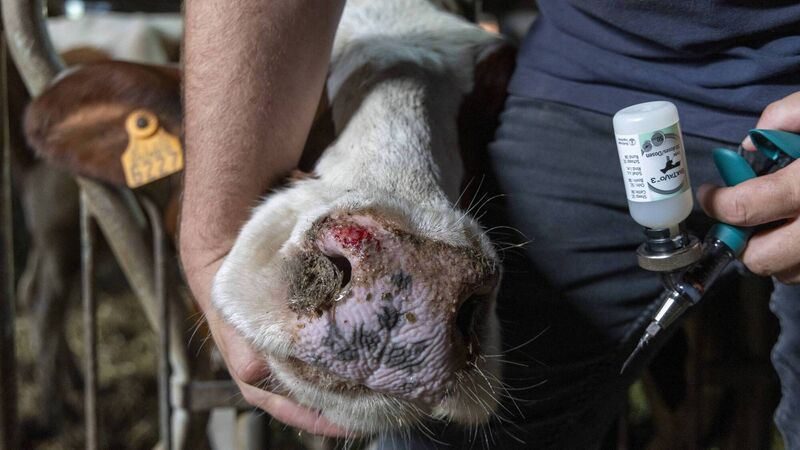Bluetongue high-alert period coming to an end

A vet administers a dose of Bultavo 3 vaccine to a cow during a visit to a farm with some cows affected by the virus causing bluetongue disease, in Scheldewindeke, Oosterzele, Belgium. Picture: Nicolas Maeterlinck/Belga Mag/AFP via Getty Images
Colder weather has been welcomed by Irish farmers, who feared the arrival of bluetongue disease could burst the bubble of high cattle prices.
"The higher risk period for incursion of windblown bluetongue virus-infected midges from GB and mainland Europe is coming to an end, as temperatures steadily decrease", said vets at the Department of Agriculture.
But vigilance remains critical to detect any cases promptly, before the virus can become established in livestock, and in the midges that spread it. Early detection would help to protect Ireland’s bluetongue disease-free status. Finland, the Baltic states, Slovakia, Hungary, and parts of Poland and Italy are the EU's other bluetongue-free areas.
Over 30 serotypes of the virus have been identified, each having distinct clinical and epidemiological profiles.
The emergence of BTV-8 in northern Europe in 2006 represented a significant shift. Outbreaks caused significant losses through morbidity, mortality, production losses, and trade restrictions.
BTV-8 still circulates widely in mainland Europe, reported for the first time this year in Bulgaria, Croatia, and Slovenia.
BTV-3 was detected in sheep in the Netherlands in September 2023, associated with severe clinical disease and rapid spread, and BTV-3 appeared last year in Germany, France, Belgium, Denmark, Spain, Portugal, and the UK.
BTV-3 has continued to circulate in England (60 cases reported since July) and mainland Europe. BTV-3 vaccination is now permitted in Northern Ireland, with a Department of Agriculture, Environment and Rural Affairs-issued specific licence.
It remains a bluetongue disease-free country — therefore, movements of vaccinated ruminants from Northern Ireland to Ireland are still permitted, subject to all usual conditions, according to the Department of Agriculture.
Meanwhile, the Welsh and Scottish governments have eased movement restrictions on ruminants because the lower temperatures are expected to prevent midges from spreading the virus.
During the 2023 outbreak in the Netherlands, the sheep fatality rate in clinically-affected animals was 74.8%. Sheep bluetongue symptoms include fever, lameness, swelling of the head, lips, and tongue, and sores or ulcers in the mouth and nose, which can cause drooling and nasal discharge.
The clinical signs observed in cattle are typically less severe and include fever, lethargy, conjunctivitis, nasal discharge, and crusting of the lips, nose, and teats.
A recent report from the east of England on infection of cows during pregnancy described reduced fertility, abortion, stillbirth, and the birth of "dummy" calves with congenital brain lesions in January 2025 on three suckler farms. Between 5% and 17% of calves born were affected, and on one farm, 20% of the breeding animals were found to be barren.
Infected cattle may harbour high levels of virus in their blood for a prolonged period, potentially an important reservoir of infection and spread by the Culicoides midge.
Transmission of BTV typically occurs between May and October, when these midges are most active. In Ireland, insect numbers increase in late spring and early summer, peak in the late summer or early autumn, and fall dramatically as temperatures drop.
But the virus can overwinter in infected midges, in a ruminant host, and by transplacental transmission and the birth of infected lambs or calves.
Long-range dispersal of midges occurs at high altitudes. The BTV-8 is believed to have come about 380 kilometres into the UK from Belgium in 2007.
Movement restrictions, enhanced surveillance, and vaccination, are the key actions in controlling the spread of bluetongue.
Although Ireland has no history of bluetongue, our proximity to northern France and the UK, where infection has become widespread, together with the changing epidemiology of the disease itself, means the risk cannot be overlooked.
Vets and farmers play an important part in monitoring for disease and should be aware of, and vigilant for, the clinical signs, and report any suspected cases.











